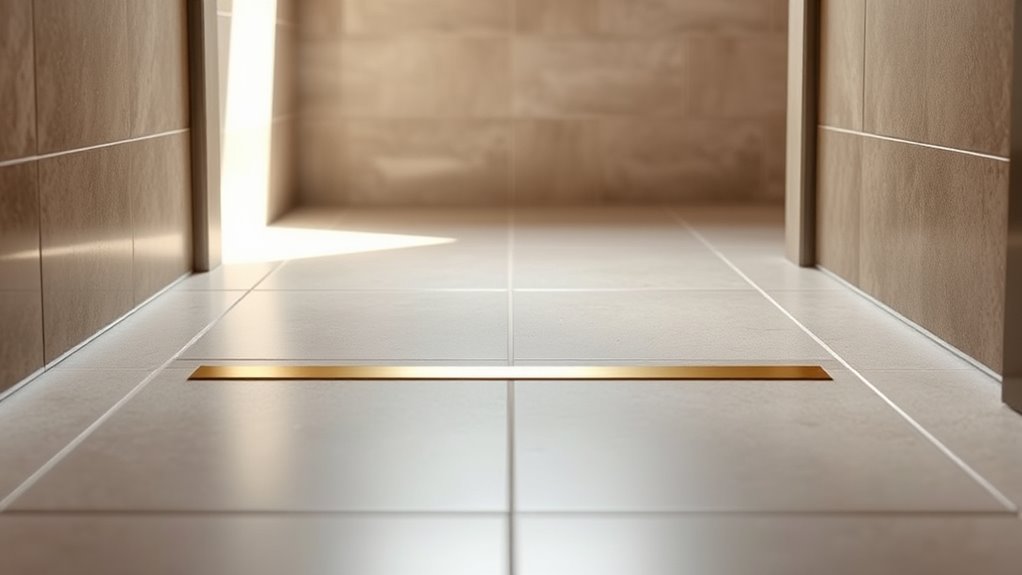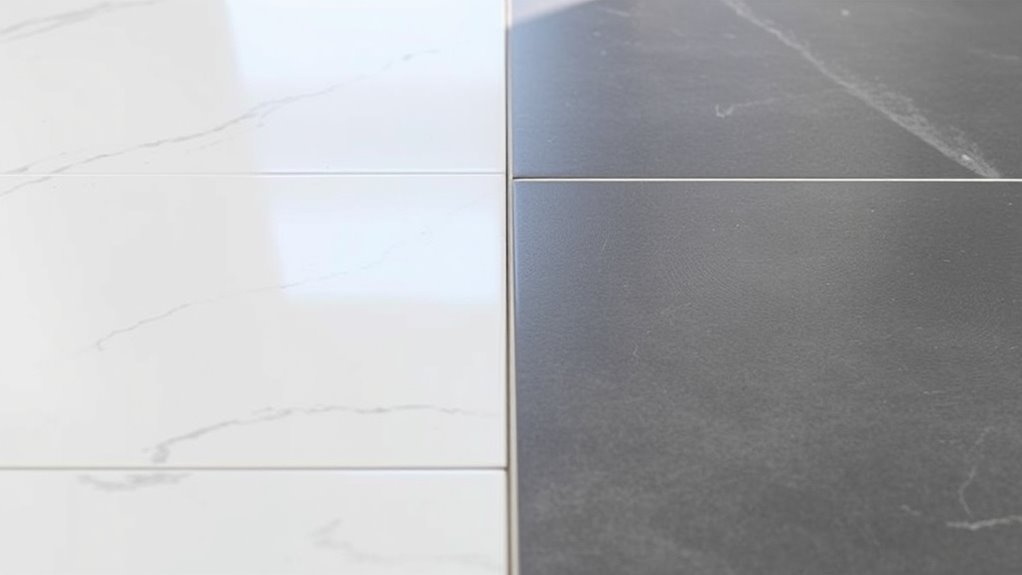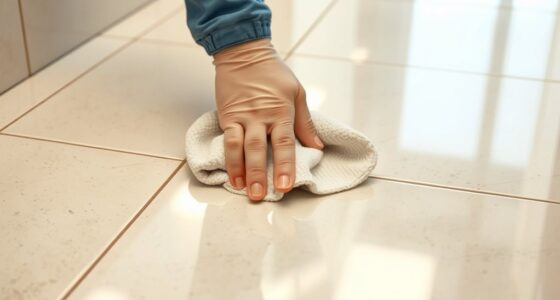Choosing the right threshold for your tile floor is key to creating a safe, seamless connection between rooms. Measure height differences accurately to pick a threshold that matches your flooring and prevents trips or gaps. Opt for durable materials like metal or vinyl for high-traffic areas, and guarantee proper installation with the right adhesive and level adjustments. When installed correctly, thresholds improve both safety and style—if you want tips on making crossings really work, keep exploring.
Key Takeaways
- Measure height differences accurately to select the proper threshold type and avoid gaps or trip hazards.
- Choose durable, appropriate materials (metal, wood, vinyl) that complement both tile and adjacent flooring.
- Ensure thresholds are installed level and securely with suitable adhesive or fasteners for stability.
- Use low-profile thresholds where clearance is limited, and verify they do not interfere with door swings.
- Seal edges and regularly inspect thresholds to prevent dirt buildup, looseness, or damage, maintaining safe crossings.

Ever wondered how to create a smooth passage between different rooms or flooring types? Thresholds on tile floors are the perfect solution, but getting them right requires attention to detail. When installing thresholds, you want to make certain they not only serve their functional purpose but also blend seamlessly with your overall design. That’s where installation tips and design considerations come into play. First, measure carefully. Accurate measurements of the height difference between your tile floor and adjacent flooring are essential. This helps you select the right threshold type—whether it’s a beveled, flat, or transition strip—so it fits snugly without creating a trip hazard or an unsightly gap.
Creating seamless transitions with carefully measured thresholds enhances both safety and design.
Next, consider the material of your threshold. Metal, wood, and vinyl each have their pros and cons, but your choice should complement both your tile and the adjoining flooring. For example, a metal threshold can add a sleek, modern touch, while wood provides warmth and a classic look. Once you’ve chosen the material, pay close attention to installation tips. Use a level to verify your threshold sits evenly, preventing any uneven surfaces that could cause stumbling. Secure the threshold with appropriate adhesive or fasteners, depending on the material and the subfloor. For tile floors, epoxy or tile-compatible adhesive often works best, as it bonds well to the tile surface and provides stability.
Design considerations are just as critical. Think about the transition’s visual flow—match or contrast the threshold with your tile and flooring for a cohesive look. A well-chosen threshold can subtly enhance your space, guiding the eye and creating a harmonious transition. Also, consider the foot traffic in the area; high-traffic zones may require more durable thresholds that can withstand wear and tear. For doorways, ensure the threshold doesn’t interfere with door swings or hinges. Sometimes, a low-profile threshold works better to maintain clearance, especially in spaces with sliding doors or low-clearance entries.
Lastly, don’t forget about maintenance. Smooth, sealed edges are easier to clean and less likely to trap dirt. Regularly check your thresholds for looseness or damage, and re-secure or replace them as needed. Properly installed thresholds not only improve safety but can also help protect your flooring investment from damage over time. When you pay attention to installation tips and design considerations, thresholds become more than just functional crossings—they enhance your space’s aesthetic and safety. Properly installed, they create a seamless, stylish transition that makes your flooring look intentional and polished. With careful planning and execution, your thresholds will not only work well but also add a finishing touch to your overall design.
Frequently Asked Questions
How Do I Choose the Right Threshold for My Tile Floor?
To select the right threshold for your tile floor, consider its durability and how well it matches your aesthetic options. You want a threshold that withstands foot traffic and movement, so look for durable materials like aluminum or brass. Also, choose a style and finish that complements your tile and interior decor. Measure accurately to guarantee a proper fit, and pick a threshold that balances both function and style for seamless passages.
Can Thresholds Prevent Water Damage Between Different Flooring Types?
Like a sturdy shield, thresholds can prevent water damage between different flooring types. They work by creating a seamless doorway passage that blocks moisture from seeping through. Properly chosen thresholds act as effective moisture barriers, especially when combined with proper installation. This prevents water from infiltrating beneath flooring, protecting your space from potential damage and mold. So, yes, well-designed thresholds are essential for keeping your floors dry and durable.
Are There Thresholds Suitable for Wheelchair Accessibility?
Yes, there are thresholds designed for wheelchair accessibility. You should look for threshold designs with low profiles, ideally under 1/2 inch, to facilitate smooth transitions. Material considerations are essential—use durable, slip-resistant materials like aluminum or rubber that won’t create hazards. Proper installation and compliant design help maintain accessibility, making it easier for wheelchairs to cross seamlessly while also preventing tripping or stability issues.
How Do I Install Thresholds on Uneven or Sloped Surfaces?
Installing thresholds on uneven surfaces is like smoothing out a rough path. You should start by cleaning and leveling the area, then use a suitable adhesive or threshold strip designed for uneven surfaces. Secure the threshold firmly, ensuring it connects smoothly over slopes. For extra stability, consider adding shims or sealants. This approach creates a safe, accessible crossing, making your space more functional and comfortable for everyone.
What Materials Are Best for Outdoor Tile Thresholds?
For outdoor tile thresholds, you want durable threshold materials like aluminum, brass, or stainless steel, which withstand weather and heavy foot traffic. Porcelain or stone can also work if they’re rated for outdoor use, offering excellent outdoor threshold durability. These materials resist moisture, temperature changes, and wear, ensuring your threshold remains functional and attractive over time. Choose the right threshold material based on your climate and aesthetic preferences.
Conclusion
Now that you know what makes a threshold work, you can turn your tile floor into a seamless journey. Think of these thresholds as gentle gatekeepers, guiding your steps like a friendly host welcoming guests. With the right crossing, your home becomes a dance floor where every step flows smoothly. So, choose wisely, install confidently, and let your threshold be the bridge that connects comfort with style—making every doorway a promise of effortless passage.









